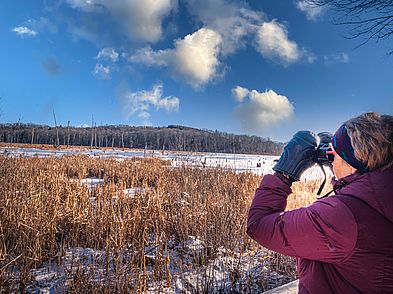Carter Fields
View Successional Wetland, Heron Rookery
A trail within mixed hardwoods opens to a dramatic wetland habitat that can be more closely observed on a water-side viewing platform, where you can observe a successional wetland. A memorable spot for birding and wildlife observation.
Please wait, map is loading.
Location, Directions & Parking
- Carter Field Road, Boxford (Opens in Google Maps)
Park next to the playing field.
Nature is dynamic. What was recently an active heron rookery supporting up to 90 pairs of herons and their young each May and June continues to evolve. Once an abandoned cow pasture, the field came into forest.
In the 1990s, beavers dammed a small stream nearby, creating a wetland of standing dead trees. These trees attracted herons who built nests high in the sky, away from ground predators. Over time, as the dead trees fell, the heron relocated to another more suitable habitat. From the viewing platform you now can observe a successional wetland.
When Indigenous people came to this area prior to English settlement, the wetland probably was only seasonal and the area dominated by hardwood forest. The People were the Pawtucket, or Agawam, and their nearest settlement with access to the Merrimack was on the Cochichewick River in North Andover.
Carter Fields is located in an area with a significant core of conserved land owned by the town of North Andover, including the Mazurenko Farm (104 acres), Carter Hill (27 acres), and Barker Hill (55 acres). All of these parcels and Carter Fields are part of the Lake Cochichewick watershed, North Andover’s sole source of drinking water.
The forested areas consist of mixed hardwoods. Common plants found in the shrub swamps include alders, willows, elderberry and highbush blueberry. In spring and summer, the wetland edge abounds with skunk cabbage, with cattails visible in the water.
The large wetland is home to beaver and muskrat while deer are active along the edges. Ducks, geese, egrets, woodpeckers and flycatchers can all be seen. Painted turtles are common basking on logs, and the sound of calling wood, tree and bull frogs fills the air.
Get GreenbeltGo Trails App
Land Acknowledgment
The properties that Greenbelt conserves are on the ancestral lands of the Pennacook and the Pawtucket, bands of Abenaki-speaking people. Join us in honoring the elders who lived here before, the Indigenous descendants today and the generations to come. Learn more…



